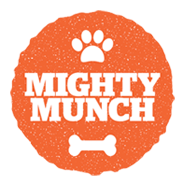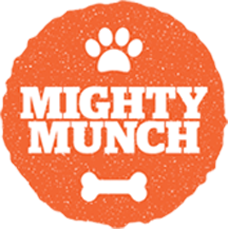We pay a lot of attention to our dog’s coat, paws, and skin, but sometimes we forget just how important their dental health is. Periodontal disease, a common but preventable condition, affects a significant number of dogs and can lead to serious, painful health issues if left untreated.
Understanding the stages of dental disease in dogs is essential for early detection and effective treatment. You could potentially save thousands of dollars, and more importantly, keep your dog pain-free and comfortable, with the right preventative measures and early treatments.
In this article, we’ll explain the different dog periodontal disease stages, and how to protect your dog’s oral health. One of the best solutions for canine dental care is Mighty Munch dog dental chews, which are formulated to fight plaque and tartar and give your pup the best possible dental care.
So, what are the stages of dental disease in dogs, and how can you use Mighty Munch dog dental chews to save your dog the pain and suffering that comes with dental disease? Read on to find out!
What is Dog Dental Disease (Periodontal Disease)?
Before we talk about the specific stages of dental disease in dogs, what is it? Dog dental disease, also known as periodontal disease, is an infection and inflammation of the structures surrounding a dog’s teeth.
It begins with the buildup of plaque, a sticky film of bacteria that forms on teeth. If not properly removed, this plaque hardens into tartar, leading to irritation and inflammation of the gums (gingivitis).
Over time, the condition progresses deeper below the gum line, affecting the tissues and bones that support the teeth. Left untreated, periodontal disease can cause pain, bad breath, tooth loss, and even lead to systemic health issues as bacteria enter the bloodstream and affect vital organs.
It’s estimated that this common condition affects a staggering 80% of dogs by the age of three. Given that it’s so common and serious if left untreated, it’s essential for dog owners to understand the different dog periodontal disease stages, which we’ll explore next.
Overview of the Dog Dental Disease Stages
This condition progresses through five distinct stages of dog dental disease, ranging from perfectly healthy teeth and gums to severe periodontal disease that can impact your dog’s overall health. Let’s take an in-depth look at the different stages of dental disease in dogs.
Stage 0
Stage 0 represents optimal dental health, where your dog’s teeth are clean, and the gums are pink and free of inflammation. There is no plaque or tartar buildup, and your dog shows no signs of discomfort while eating or chewing.
Regular brushing, investing in the best dental sticks for dogs, and professional cleanings are the best way to keep dogs teeth clean and are essential at this stage to maintain oral health and prevent the progression through the dental disease stages in dogs.
Stage 1
In Stage 1, the initial signs of dental disease begin with mild gingivitis. You may notice slight redness or swelling along your dog’s gum line due to a buildup of plaque on dog’s teeth.
At this stage, there is minimal or no bone loss, and the condition is still fully reversible with proper dental care, including professional cleaning and consistent at-home brushing dogs teeth vs dental chews.
Stage 2
Stage 2 is marked by moderate gingivitis and the presence of tartar. The gums may appear more inflamed, and there could be minor bleeding during brushing. At this stage, up to 25% of the bone supporting the teeth may be lost.
Although early periodontal disease is still manageable, it requires professional scaling and polishing to remove tartar, along with improved home dental care to slow further progression.
Stage 3
By Stage 3, periodontal disease has become more severe. The gums are significantly inflamed, and up to 50% of the bone supporting the teeth may be lost. Your dog is generally in a lot of pain at this point.
Pockets form between the teeth and gums, where bacteria thrive, leading to bad breath, pain, and possible difficulty eating. More advanced dental procedures, including deep cleaning and possible extractions, may be necessary to prevent further damage.
Stage 4
Stage 4 is the most severe of the stages of dog dental disease. The gums are severely inflamed, with deep pockets and significant bone loss exceeding 50%. Teeth may be loose or even fall out, and your dog is likely experiencing constant pain.
As well as severe bad breath, there may be pus around the teeth, and systemic health issues could arise as bacteria enter the bloodstream. At this stage, extensive dental work, including extractions and surgical procedures, is often required.
Why Treating Periodontal Disease in the Early Stages is So Important
Understanding the stages of dental disease in dogs is so important, because it enables you to identify issues early. Learning how to prevent dental disease in dogs is best, but treating the early dental disease stages in dogs is also crucial, to prevent your dog from permanent damage or tooth pain.
Preventing Irreversible Damage
In the initial dog periodontal disease stages, dental disease primarily involves gingivitis, which is fully reversible with the right care. Once the disease progresses beyond Stage 1, however, damage to the supporting structures, including bones and tissues, can become permanent.
If left untreated, this irreversible damage can lead to tooth loss, infections, and chronic pain for your dog. By treating the condition early, you can prevent these serious outcomes and help maintain your pup’s oral health long-term.
The Speed of Progression
Periodontal disease can escalate quickly, especially once it progresses beyond the early dog dental disease stages. Plaque hardens into tartar within days, and inflammation can swiftly lead to bone loss and deeper infections.
Early detection and treatment can halt this rapid progression before significant damage occurs. Regular checkups, routine cleanings, and at-home care with dental chews are key to catching the disease early and keeping it under control.
Cost-Effectiveness of Early Treatment
Treating periodontal disease in its early stages is not only better for your dog’s health but also more cost-effective. Preventive care, including routine cleanings and at-home dental hygiene, is far less expensive than the more complex procedures required for advanced stages of the disease.
As the condition progresses, your dog may require deep cleanings, extractions, or even surgery, all of which come with significantly higher costs. Investing in early treatment and preventive care saves both money and the stress of managing more severe complications later on.
Tips on Preventing or Addressing Dog Dental Disease
As well as understanding and recognising the different dog periodontal disease stages, it’s also important to learn what you can do to protect your dog’s dental health at each stage. Here are our tips for preventing and addressing dog dental disease.
Regular Brushing and Flossing
Just like in humans, regular brushing is one of the most effective ways to prevent plaque buildup and the progression of dental disease in dogs. Brushing your dog’s teeth daily, or at least several times a week, helps remove food particles and bacteria that can lead to plaque formation.
Use a dog-specific toothpaste and a soft-bristled toothbrush to ensure their comfort and safety. Flossing is less common in dogs, but still effective. However, when it comes to dental sticks vs floss, there’s no denying that most dogs would prefer to chew on a dental stick!
Use Mighty Munch Dental Chews
Are dental chews bad for dogs, or are dental sticks good for dogs teeth? Dental chews and sticks are actually one of the best preventative measures to combat dental disease in dogs, and you can find the most effective ones here at Mighty Munch! But how do dog dental chews work?
Our dental chews are made from premium ingredients, including a potent dog probiotic. As your dog chews on a dental stick, the mechanical action helps to scrub away the plaque and tartar from your dog’s teeth. Plus, they fight the bad bacteria responsible for plaque and tartar in the first place.
You could try making homemade dog dental chews, but we’ve saved you all the time and effort by perfecting our formula for maximum efficacy. With premium ingredients and no fillers or unnecessary additives, you can be sure your dog is getting nothing but the best with Mighty Munch.
When can you give puppies dental sticks? We recommend waiting until your pup is six months old so that they can safely chew on their stick and enjoy the benefits. And how many dental sticks can a dog have a day? One dental chew per day is perfect!
While you’re here, make sure you check out our other products, including our premium Australian dog supplements. We have the best probiotics for dogs Australia and dog joint supplements to keep your dog mobile and pain-free.
We also have top rated orthopedic dog beds Australia that help your dog get the peaceful, soothing sleep they need, and the best pet odour eliminator Australia - pet-safe but industrial strength to tackle even the stinkiest pet smells!
Regular Veterinary Check-Ups and Professional Cleanings
Even with diligent at-home care, professional vet check-ups and cleanings are crucial for maintaining your dog’s dental health. Regular vet visits allow for early detection of dental issues, and professional cleanings help remove tartar that cannot be eliminated by brushing alone.
How often should dogs have a dental cleaning? If you’re very careful with your at-home dental care, like using daily dental chews and brushing your dog’s teeth regularly, you can reduce the dog dental cleaning cost by scheduling annual appointments for your pup.
Diet and Nutrition
Your dog’s diet plays a key role in their dental health. Feeding them a balanced diet with the right nutrients supports strong teeth and healthy gums. Dry kibble, for example, can help reduce plaque buildup compared to soft, wet food, which tends to stick to teeth and gums more easily.
There are also specially formulated dental diets and treats that promote oral health by reducing tartar and plaque. Always consult with your vet to choose the best diet for your dog’s specific needs and to ensure they are receiving the right nutrients for optimal dental and overall health.
Closing Thoughts on the Dog Periodontal Disease Stages
So, that wraps up our guide on the stages of dental disease in dogs. Understanding these stages is important for all dog owners, as is doing everything you can to prevent dental disease in your pup, keeping them healthy and pain-free.
One of the best methods for dog dental care is giving your dog a daily Mighty Munch dental chew. Dental chews can help your dog fight plaque and tartar, and ensure the bacteria responsible for periodontal disease are kept under control.
Prevent painful, expensive, and potentially life-threatening dental issues - invest in Mighty Munch dental chews for your pup’s oral care!


